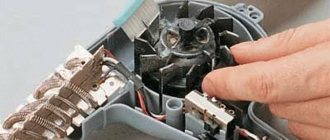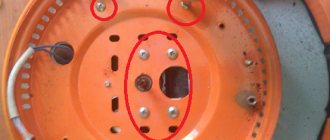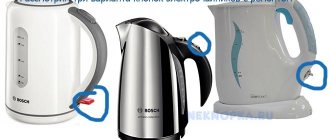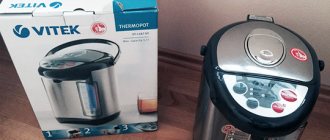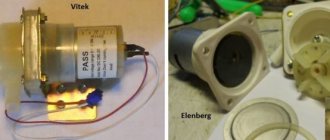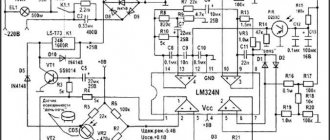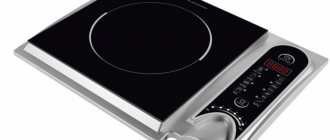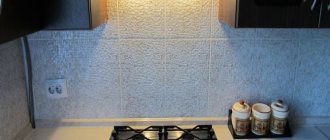Household appliances have become a part of our lives and have greatly simplified them. There are both pros and cons to this at the same time. On the one hand, household transactions have become much more convenient. On the other hand, if the refrigerator, washing machine or stove breaks down, most will not know what to do.
Problems can arise with any household appliance. The teapot is no exception. Cases are different. But one of the most common is that the kettle does not turn off when it boils. Let's figure out why.
Electric kettle
Kettle design
To deal with the breakdown, you need to understand the principle of operation of the equipment.
The design of the kettle is extremely simple. After pressing the power button, electricity is supplied to the heating elements. They are called heating elements, or tubular heating elements. The heating element is located either in a special stand or in the bottom of the device itself - it depends on the model.
The water gradually warms up. After crossing the threshold, hot steam begins to form. Since the lid is closed, the steam needs to escape somewhere. For this purpose, a channel is adapted that leads to the shutdown button. In front of the switch there is a bimetallic plate that acts on it. This mechanism disconnects the equipment from the network.
Device operation diagram
When to contact a specialist
Experts do not advise starting to repair an electric kettle on your own in the following situations:
- when a person does not have the necessary knowledge and practical experience in this matter;
- when a breakdown is observed in the thermostat;
- in a situation where a crack or chip has formed in the body of the kettle;
- when it is necessary to change or repair the heating element in a model with a closed type of heater.
Thus, premature shutdown of an electric kettle even before the water boils can be caused by a large amount of scale on its walls and heating element or a breakdown when the thermostat or fuse fails. Other reasons are chips and cracks on the case or poor fixation of the heating element inside the device. If scale can be cleaned at home, then in other situations it is better to contact a service center and have the electric kettle repaired.
Video about turning off the kettle
Causes of failure
Now that the principle of operation is known, it is much easier to understand why the electric kettle stopped working and does not turn off on its own when it boils. There may be several reasons:
- The most common reason is that the lid is not closed, or is not closed tightly. Instead of steam moving through the channel, it will escape through the cracks to the outside. Because of this, the shutdown mechanism will not work.
- There is no filter or it is installed unevenly. Because of this, the lid does not fit very tightly to the edges. Gaps are formed through which steam escapes.
- If you don't take care of your kettle, scale will form over time. This will be immediately noticeable by the plaque inside.
- The steam outlet channel is clogged. This can happen in older models. In newer ones, the creators took this shortcoming into account.
- Breakage of the switch. Changes are mandatory without exception.
- Damage to the plate, which cuts off electricity when heated. Of course, in this case you can turn off the kettle manually. But it is still advisable to repair it to avoid fire or smoke.
- Contacts sticking. Simply wipe and clean the contacts with sandpaper to solve the problem.
Some of the reasons can be solved by prevention and proper care of the kettle. Descale, close the lid tightly, turn off the kettle during power surges and do not heat it many times in a row. For other faults, DIY repairs are possible. You just need to know what exactly to do.
The electric kettle does not turn on or off
The reasons for the breakdown of an electric kettle, like any electrical installation, often lie in the electrical part, but an electric kettle can turn on or not turn off for other reasons.
Let's look at the main breakdowns of an electric kettle.
- It’s trivial that the socket may not work or there may be no voltage in it (it worked automatically, for example).
- The coil or heating element has burnt out. This happens due to poor quality manufacturing or excessive temperature of the heater. The temperature rises due to the fact that scale has formed on the heater platform or on the spiral heater from the water and the heater has begun to dissipate heat poorly. If heat is not transferred outside, the temperature inside the heater increases, which leads to a break in the heater filament. The heater is checked using a tester and replaced with a new one.
- The contacts on the area under the kettle were burnt. This happens when the kettle is placed on the platform with the button turned on. Upon first contact, a spark is formed that destroys the metal. You should first put the kettle on the platform, and then turn it on. The switch contacts are made of refractory metal, which is not afraid of switching on the load.
- The contacts on the kettle are burnt. The principle is the same as described above.
- One of the connectors has come loose. This can happen if the assembly is poor or the kettle falls.
- The thermal regulation mechanism has failed. In the normal position, the contacts are closed; when the temperature rises during boiling, the contacts open and the kettle turns off. The contacts may burn out and not conduct current. A foreign object may also get in. It happens that the thermal paste in the thermostat dries out.
- In case of poor contact, for example when the kettle is placed crookedly on the platform, the metal can heat up, the plastic will melt and the contacts will move. In this case, the smell of burnt plastic is felt and the kettle no longer turns on.
- Why doesn't the electric kettle turn off?
- The steam pipe that runs through the handle of the kettle from the lid has broken. The tube conducts hot steam to the thermostat and it turns off the kettle. Usually in this case, when boiling, you can see steam coming out of the handle.
- The thermostat is broken and the contacts are constantly closed.
Here are the main reasons why an electric kettle breaks down.
We remind you that the work must be carried out by a qualified technician.
How to fix a kettle yourself that won't turn off when it boils
First of all, the device must be inspected for visible damage. Are there any cracks or chips from which steam can escape? Is the lid tightly closed?
Open lid
If everything is in order on the outside, then you should look inside. Perhaps the filter is not inserted too tightly and is sticking out. Because of this, the lid does not close - this is one of the most common reasons.
Next you need to check if there is any scale underneath. If there is one, it makes sense to thoroughly rinse and clean the insides.
In older models, the steam channel may become clogged. Check the hole. It can be found on the side of the kettle handle. This problem shouldn’t arise in new models, but it wouldn’t hurt to check.
If you have examined all the visible parts, but there are no problems with them, then it is time to disassemble the kettle and get to the switch and bimetallic plate. To do this, you need to carefully unscrew all the retaining screws.
It is advisable to record the dismantling process on camera. This will make it easier to assemble the parts into place later.
- If the switch fails, it must be replaced. It is no longer possible to repair it yourself.
- If the contacts are stuck to each other or burnt, you will need sandpaper. It is necessary to carefully wipe each contact for several minutes. Then remove the scratches with thick felt and you're done!
Disassembled device
After fixing the problem, you need to reassemble the kettle. But it’s too early to include it online. Even if you assemble it according to the instructions, you can make a mistake.
To eliminate this possibility, you need to place a towel under the bottom and wait about half an hour. If the towel does not get wet during this time, then the kettle is assembled correctly. And even then it can be connected to the network without any problems.
How to troubleshoot
If the electric kettle does not automatically turn off after boiling water, the first thing to do is inspect :
- Check that the lid is closed and that there are no chips or cracks through which steam is escaping.
- They look at how the filter is installed inside the equipment . It should stand level so that the lid of the kettle fits tightly to the edges.
- Check for scale on the walls and bottom . If scale has formed in the electric kettle, it should be thoroughly cleaned and washed.
- through which steam moves to the switch is clogged The channel opening is located on the handle side between the lid and the wall. It should be clean, without scale plugs. Most often, the hole gets clogged in older models, since it is very small. If the hole is clogged, it is cleaned.
If there are no visible faults, then the breakdown is more serious , and its elimination requires technical knowledge. To find it, the household appliance is disassembled.
Interesting things on the site:
Why doesn't water flow into the dishwasher?
Why does a microwave oven not heat food well?
Why does water accumulate under the vegetable drawer in the refrigerator?
Take it for repair or fix it yourself
Some breakdowns are difficult to fix at home on your own , so contact a qualified technician. If the plate, switch or microcircuits are broken, this indicates improper operation of the electric kettle.
After consultation with a specialist, they determine what is more profitable - repairing the old equipment or buying a new one. If repairs cost less than buying a new kettle, the device is taken to a workshop.
Advice. When purchasing, choose a high-quality electric kettle with a guarantee from a reputable manufacturer. It will last longer than cheap Chinese counterparts.
DIY repair
When repairing it yourself, an electric kettle that does not turn off after boiling water is disassembled to get to the switch, bimetallic plate and contacts . To do this, unscrew the screws on the bottom cover and remove it. Unscrew the screws on the handle.
When disassembling, remember the sequence of actions to make it easier to put everything back together.
Advice. To facilitate the subsequent assembly of the household appliance, record the disassembly process on camera.
First, inspect the switch . If it breaks, the part is replaced with a similar one. It is not recommended to repair the switch yourself - this may lead to incorrect operation of the device.
If the contacts are burnt or oxidized , they are cleaned with fine-grained sandpaper. Then wipe with thick felt to remove scratches.
If the power button fails , it is replaced with a new one.
The device is then assembled. Before turning on, check whether everything is done correctly . To do this, pour water into the electric kettle, place it on a towel and wait 30 minutes. If the fabric does not get wet during this time, it means that the device is assembled correctly and can be used.
A wet cloth under the kettle indicates that the seal may have been dislodged during repairs. Then the equipment is disassembled again and the gasket is put back in place.
Fire safety
Why is it worth paying special attention to equipment if it does not turn off on its own? The point is the risk of losing your property. And it's not just a teapot.
Pampered users are accustomed to the fact that almost all equipment works automatically. And many can put the kettle on to warm up and go to another room or leave the apartment altogether.
The water gradually begins to evaporate. Eventually, the process will reach the point where there is absolutely no water left in the equipment. And if the kettle simply breaks down, it will be a huge luck. After all, there is a risk of fire.
Therefore, in case of such a breakdown, you need to pay special attention to the electric kettle. And either immediately start repairing it, or not use the device.
How to prevent breakdowns in the future
To prevent further damage, the electric kettle is used correctly:
- close the lid tightly;
- install the filter so that it stands level and does not interfere with the lid closing;
- do not use the device during voltage fluctuations in the electrical network;
- Do not heat the water many times in a row.
The smooth operation of equipment also depends on proper care . The kettle is filled only with purified water and descaled periodically.
To ensure that the electric kettle lasts longer and without breakdowns, buy high-quality equipment from trusted brands with warranty service.
When to take it to a specialist?
Device repair
Breakdowns are not so simple. Then you can’t eliminate them with your own hands. If the microcircuits are completely out of order, the switch is covered, and the plate does not work, it means that the equipment was not operated correctly.
Now you need to calculate whether it makes sense to restore the kettle. What is its cost? How much will it cost to repair and purchase new equipment? What will be more profitable?
If it would be more profitable to repair an old kettle, then you should take it to a specialist. He knows how to fix it.
The most economical thing would be not only to buy good branded equipment with a guarantee. But also use it correctly: pour clean water, clean it on time and do not overheat. But if problems still arise, the instructions above will help you restore the device.
How to properly disassemble a thermopot
- The first step is to remove the top cover, as it will get in the way. The next thing to do is turn the device upside down and use something flat and sharp to remove the corkscrew ring, such as a screwdriver or knife. To perform this action, it is worth using some physical force.
- Several screws will appear under the corkscrew ring; they can be easily unscrewed using a shaped screwdriver.
- The next step is to remove the bottom of the kettle using a knife or flat screwdriver, which requires little effort, because the bottom is secured with latches.
After that, all the electronic stuffing is before your eyes. Now you need to check all terminals for connection strength.
Minor damage to the kettle may occur. In such cases, you can repair the thermopot yourself.
The kettle turns off before the water boils: reasons, disassembly and DIY repairs
- insufficient knowledge, experience and self-confidence;
- The thermostat needs to be repaired or replaced;
- you need to repair the crack in the flask body;
- We have to work with a closed-type heating element.
Useful tips Connection diagrams Principles of operation of devices Main concepts Meters from Energomer Precautions Incandescent lamps Video instructions for the master Testing with a multimeter
| I couldn’t find any information on this problem on the internet, someone was also interested, but no answer, apparently the problem is unique to mystery. I decided to ask the experts what this blinking means? |
| Serg2278 wrote: |
| I couldn't find any information on this issue on the Internet. |
Replacing the pump if the thermopot does not pump water
- After removing the metal casing, disconnect the tubes from the pump. If you find scale on the wires, you need to get rid of it.
- Disconnect the pump itself from the tank and housing, while trying not to lose all the small parts.
- As soon as the pump and the electric motor are disconnected, remove all scale that interferes with the proper operation of the device.
If the thermopot does not pump water, then it is necessary to replace the pump
Like any household appliance, a thermopot needs care and maintenance. You can descale it at home using citric acid, acetic acid and baking soda. The thermopot should be cleaned immediately, as soon as the first scale appears. If the product begins to make suspicious sounds, then cleaning is all the more necessary. This is the first signal for help.
If after all these manipulations there is no water supply, then you need to change the pump itself - buy a new one. There is no point in restoring a damaged pump.
Main reasons for premature shutdowns
The main reason for this problem is the long service life of the boiling unit. Over many months of operation, a layer of scale and soot forms on the heater, which reduces heat transfer. Because of this, the heating element overheats, and, as a result, the protection mechanism is triggered. Even if there are only a few seconds left before the water boils, the thermostat turns off the device earlier, since it interprets this situation as a fire hazard.
Most often this happens with open-type heating elements. In such cases, you can carry out the repair yourself. And if in models with disk heaters it is enough to boil the flask with a solution of citric acid or vinegar several times, then the spiral must be removed and cleaned with a knife. You need to remove the plaque carefully, but at the same time being careful not to damage the coating of the element. Then the part should be wiped until shiny with a dry cloth. After this procedure, the heater becomes like new, the problems stop and the kettle continues to serve for a long time.
Due to age, the thermostat may not work correctly. After many years of regular expansion and contraction, the bimetallic strip becomes deformed and begins to turn off at the wrong time. Taking advantage of the fact that the protection is duplicated and both thermostats are identical, some masters swap them. Often this solves the problem.
Important! It is strongly not recommended to replace a faulty thermostat with a backup one yourself, as this may lead to a fire.
It's better to try to bend the plate into place. The measure, although temporary, is more reliable. Don't forget about low-quality Chinese stampings. The service life of such products is short, and, as a rule, they cannot be repaired.
Typical breakdowns and their elimination
Devices manufactured according to the same design are characterized by typical malfunctions. How to find and eliminate them will be described in pictures below.
Doesn't turn on
If the device does not turn on, then the problem is that the electrical circuit contacts are broken. The only question is where the break occurred. You need to start checking with the power cord. If it is unusable, replace the wire with a new one. Then all connections of both thermal switches must be checked. Perhaps an emergency trip occurred, and due to a faulty thermostat, the contacts did not return to place. Also, the connection at the thermal fuse may not be restored. To check, you need to disconnect the questionable part and short-circuit the wires directly. If this works, the defective part is replaced with a new one.
Constantly boils water
A situation where the water constantly boils and the device does not turn off can only occur with the most budget models with one thermostat. It is because of its breakdown that the thermopot does not turn off after boiling. Here you should immediately, without any checks, change the thermal switch. Good and reliable samples always have a backup thermostat. And some manufacturers install additional control in the form of a thermal fuse, which will protect you if for some reason both protections do not work and the kettle constantly boils water.
Shuts off before boiling
Usually this only happens with devices that have been in operation for more than one year. This is due to the loss of its properties by the bimetallic plate in the thermostat, which over time begins to react to a lower temperature than planned. To correct the situation, you can try to temporarily bend the contacts at the plate. The best solution would be to replace the thermal switch.
Banal scale may be to blame for the fact that the thermopot has stopped boiling water. As it settles in a thick layer on the heating element, it reduces its thermal conductivity. The heating element gradually begins to overheat. At a certain point, the thermostat sees this as a fire threat and opens the electrical circuit moments before the water boils. You can get rid of scale on heating elements by simply boiling a solution of citric acid. If this does not help, you will have to disconnect the heater and clean it with a knife.
Another cause of breakdowns can be poor contacts. In this case, you should check all connections to the wires of the heating element and thermal switch. If necessary, the contacts are resoldered.
Water supply button does not work
If the water supply button does not work, there may be several reasons. First of all, this could happen due to a blockage in the system. Garbage most often consists of scale particles that settle on the walls of tubes and hoses, gradually reducing their clearance. This ultimately leads to the pump not pumping water.
To remove scale, you also need to use citric acid or vinegar by boiling water with them in the device. In the case of insoluble debris, the pump and the entire water system will have to be completely disassembled. To do this, you need to disconnect all the hoses and blow them out. The pump itself should be disassembled as follows:
- disconnect it from the device body;
- unscrew the impeller and clean the scale from it;
- remove dirt from the magnet.
The liquid filling button also does not work if there are poor contacts on the button itself or at the junction of the wires with the electric pump. To eliminate it, you need to check the entire circuit for breaks. If the second heating element fails, voltage is no longer supplied to the electric pump motor.
The auto-fill may not work if there is a problem with the control module. In this case, you need to check the board for cracks and burnt parts, if found, you will have to work with a soldering iron.
Doesn't heat water when the light is on
When the device does not heat water when the indicator is on, the first thing to do is check the heating element. But if the heater is working properly, then the reason may lie in the electrical circuit. That is, the thermopot does not heat the water, but the light comes on if there is a fuse in the circuit after the indicator that has blown. To fix the problem, the faulty part must be replaced.
Other faults
If the thermal kettle operates for a long time or incorrectly, other problems may occur.
- Reboiling does not work - the reason must be sought in the additional heater and control module.
- There is no main boil, while the restart button works - you should check the thermostat.
- The thermopot only works for heating, but does not boil - the culprit is a burnt-out main heating element.
Protecting electric kettles from overheating
To turn off the electric kettle:
- Due to the activation of a special automatic system.
- A bimetallic strip is used as a boiling indicator.
- Curving under the influence of temperature, it acts on the switch, opening the contact.
- The condition of the plate itself is affected by the temperature of the steam formed during the evaporation of boiling water.
- After boiling, the device does not turn off immediately, allowing the water to boil for 5-10 seconds. This is not a clever idea, the delay is explained by the fact that the steam takes time to reach the plate and heat it to the desired temperature.
This is such a simple system, the kettle doesn’t have any artificial intelligence, so you don’t have to worry about this for now. But it remains to be seen what the near future will give us; equipment has already gone on sale that can turn on and off after sending an SMS from the phone.
There is no need to disassemble the electrical appliance to understand how the automatic shutdown in the kettle works. Even without ruining the equipment, you can get hurt yourself. Especially if you forget about basic safety rules. Still, this is working with electricity.
Automatic kettle switch-off system
To avoid overheating or even fire, every modern electric kettle has a simple system
:
- There is a bimetallic plate inside the kettle.
- It consists of two metals, each of which changes its shape under the influence of temperature.
- But changes begin to occur at different indicators, so when the boiling temperature is reached, the shape of the plate changes.
- It bends inward, touches the contacts and ensures that the automatic system operates.
- In manual mode, you can turn off the kettle by pressing the button and using the same principle, but with minimal effort on the part of the person.
Thermos kettle pcf 60hmw diagram – .
Among all kinds of household appliances, many people have an electric kettle, and not an ordinary one, but a thermos kettle. In other words, thermopot. Since the cost of a new thermos kettle is quite high, times higher than the cost of a regular electric kettle, in many cases, self-repair of the thermos is not only justified, but also necessary. Let's look at the design, typical malfunctions of thermopots and methods for eliminating them using the example of repairing a kettle - a thermos brand Elenberg TH. The body of the thermopot can be easily disassembled. The rigidity of the structure is given by two bolts or self-tapping screws that secure the lower plastic part. By unscrewing both bolts and removing the plastic bottom of the thermos kettle, you can gain access to the electrical part. For ease of diagnosis, you can remove the outer metal casing by first disconnecting from it the grounding wire coming from the middle grounding terminal of the power outlet. Most thermos kettles have a similar design, regardless of the manufacturer.
Protection system
Heating elements on an electric kettle are installed during the assembly process at the manufacturer's factory and depend on its volume: the power of the heating element varies between 0.5-2.5 kW. When heated, they emit a large amount of heat, so in order to avoid a fire, the designers have provided effective protection against overheating.
Round bimetallic plates are used as temperature sensors, with a special selection made in the center. They should fit tightly to the bottom of the kettle; for better heat transfer, their surface is lubricated with a paste with excellent heat-conducting properties.
When carrying out any complex repairs, it is not recommended to remove this grease.
The plate is assembled from two metals with different coefficients of thermal expansion, firmly glued together. When heated strongly, it bends due to different expansion of the metals.
To turn off the device, the bimetallic plate is connected to the contacts by means of a ceramic rod in the following way: one end of it rests against the disk, and the other supports the plate of the contact group. The mechanism of action is very simple: the plate bends, the rod moves and the contacts are disconnected.
What to do if the thermopot boils but does not turn off
In fact, a thermopot is a reliable household appliance and it rarely fails, but it does happen. And the first thing that should alert you is when the thermopot does not turn off after the water has boiled.
How should you deal with such a situation? This is the first question that comes to your mind. The most important thing is not to panic. Below we will describe what to do in such a situation.
1. The first thing you should do is unplug it from the outlet.
2. Don’t rush to pick up a screwdriver, take the warranty card and see if the warranty is still valid and you can contact the service center. If the warranty is no longer valid, call a specialist if you yourself do not understand household appliances at all.
Disassembling the electric kettle
To understand why the device turns off prematurely, it is necessary to partially or completely disassemble it, which will allow you to quickly find the faulty unit and repair it or completely replace it. The dismantling algorithm will be considered using the example of a kettle from a brand manufacturer - Bosch. At the bottom of its case there are four screws that need to be removed. To do this, select a screwdriver that matches the screw heads. A cross is usually suitable.
But recently, the manufacturer has begun to use protection against attempts at self-repair. For example, he can hide the bolts under plastic plugs, which can be easily pulled out by prying them with something sharp. Or use one screw (or all) with a non-standard head. Then you will need a two-pronged fork type screwdriver, which can be replaced with tweezers. You can also do it yourself by sawing a groove in the flat blade of a regular screwdriver with a needle file.
The last level of protection is the clever latches on the case and the lid itself. There is an opinion that sometimes removing the cover is more difficult than making the repair itself. In this case, two thin screwdrivers will help. The first one is pushed under the lid to create a gap. And the second one in this gap is to find the place of the latch and carefully release it.
Scheme and principle of operation
To understand why this happens, you need to know the principle of operation of the kettle and its electrical circuit. The model range of these household appliances is very diverse, but the operating principle and assembly diagram are almost identical for all, with rare exceptions: for example, a built-in timer.
The electric kettle works quite simply: through a strong cord with a plug at the end, the voltage from the socket is transmitted to the XP1 contacts located in a massive stand - it is on it that the device is installed while boiling water. At the bottom of its body there is a special connector that interacts with the contacts of the stand.
The SA1 thermal switch provides manual switching on and automatic switching off of the device after the water begins to boil. The thermal protection switch is always active and does not take part in the daily operation of the product - it only works when the kettle is turned on without water. Then the current goes to the tubular heating element (TEN), and a glowing light on the indicator signals that the product is in operation.
When the water boils, steam collects in the free space between the water level and the lid of the product, then the water vapor flows through a special channel to a bimetallic plate made of two different metals, which bends when heated and opens the contacts - the thermal switch turns off.
Safety rules when using a thermopot
As practice shows, the more carefully you follow the rules for using the device, the less hassle the user has. Thermopot is no exception.
Almost all modern models are equipped with an automatic shut-off function if there is no water in the tank. But if the device is already quite old, this safety measure may not work, and you risk losing the device or getting a fire.
All models have the “Locking the filling button during operation” function. And in some models, the hand pump is also blocked during operation. Sometimes it happens that after you have poured water into the cup and released the valve, another burst of boiling water occurs. If this happens to your appliance, you should always be on guard when pouring boiling water.
If you want to drain the remaining water through the neck of the device, disconnect the lid so that it does not break off. Both the lid may be damaged (break) and your hands (burned by boiling water). Even if the manufacturer does not warn about this in the product data sheet, it is better to pay attention yourself. When you screw the lid on, do it until it clicks into place.
Expert opinion
Viktor Pavlovich Strebizh, lighting and electrical expert
Any questions ask me, I will help!
The first step is to inspect the electric kettle; perhaps in a hurry and in anticipation of a break, a colleague at work did not close the lid tightly, or an uneven filter prevented the lid from closing tightly. If there is something you don’t understand, write to me!
Do-it-yourself thermopot repair
The power supply board for a Vitek thermopot costs over 800 rubles. Textolite carries:
Network wire
The body of the thermopot is secured with several screws: unscrew the fasteners, first unplugging the plug from the socket. There will be a block inside, let's start with a visual inspection. Burnt parts inside the thermopot accurately indicate the location of the breakdown. The cord is carefully separated and rings with a tester (diode mode). A detected fault in the wire will not delay the repair of the thermopot.
Microcircuits
The technician will examine both, identifying the presence of swollen capacitors, burnt resistors, bad fuses, and broken tracks. Faulty radio elements are replaced with new ones, soldered, contacts are restored by tinning.
The first study concerns the presence of fuses and the integrity of elements. If the replacement is unsuccessful, the new element burns out - the problem is caused by the electronic filling. The thermopot is affected by a short circuit (sharp uncontrolled increase in current).
The resistor values are indicated by colored stripes. A typical problem is to detect the beginning and end of a marking.
Hint: there are special sites containing tables of various types of resistance designations. Gain access to the resource by filling out the search bar with the simple phrase “labeling resistors online.” The direction of the stripes is determined by the observed fact: a fixed set of colors meet at one edge.
Damaged electrolytic capacitors are easier to notice - the cylinders swell. Beginners looking for ways to repair a thermopot are interested in the appearance of a broken container. The answer will come automatically, as soon as a faulty capacitor is found. The appearance of the cylinder evokes the idea: the barrel is 100% swollen. The sidewall especially sticks out (imported ones are cut crosswise).
It is more difficult to test with diodes, but the semiconductor burns less often (silicon keeps temperatures below 150 degrees Celsius). Unsolder the element, ring both sides. The arrow marking shows the direction of flow of positive charges (lean against the positive probe of the tester).
Torn board tracks must be cleaned with sandpaper, removing the varnish from the metal. The shiny surface is tinned (with soldering irons), joined, and covered with solder. It will serve for decades. The mechanics repair the mechatronics and it works...
water pump
The required voltage is supplied by computer power supplies.
Heating elements and thermal switches
It is not recommended to try to replace flat sheets of metal equipped with terminals with homemade ones. The cost of heating elements on the counters starts at $45.
Protection against overheating is provided by bimetallic thermal switches. The characteristics of the thermopot are determined by the control part. Usually there are several thermal switches, one controls the water parameters, the second is protection against turning on an empty tank. In the latter case, the heating element reaches a temperature above 100 ºС and opens the power circuit.
What kind of lighting do you prefer?
Built-in Chandelier

